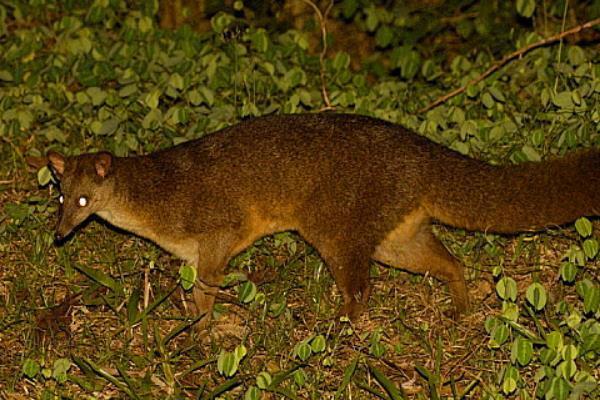Eupleres goudotii
IUCN
LCBasic Information
Scientific classification
- name:Eupleres goudotii
- Scientific Name:Eupleres goudotii,Small-toothed mongoose, sharp-nosed civet, anteater
- Outline:Carnivora
- Family:Myrmecophaga
Vital signs
- length:45-65cm
- Weight:1.6-4.6kg
- lifetime:No verification information
Feature
It looks like a mongoose, with a long snout and a low body, but is plain brown in color.
Distribution and Habitat
The sharp-nosed civet is found primarily in lowland rainforests of central and northwestern Madagascar, in primary moist and deciduous forests and associated swamps, ranging from sea level to 1,600 m above sea level. It sometimes occurs in mesophytic open grassland patches within these habitat types.
Appearance
They are small, with a body length of 45 to 65 cm, a tail length of 22 to 25 cm, and a weight of 1.6 to 4.6 kg. They have very typical characteristics of the Myrmecophaga family, with an extremely slender head that seems to be smaller than the body, a stout body, a long tail, a spinning sleeping posture, and are very shy. They look like mongooses, with a long snout and a low body, but the color is plain brown. They have no anal or perineal glands and non-retractable claws. Their tooth type is unique, with canines and premolars that are curved backwards and flat, which may be related to their uniqueness.
Details
The small-toothed mongoose (scientific name: Eupleres goudotii), also known as the small-toothed mongoose or sharp-nosed civet, is classified under the subfamily Myrmecophaga with its close relative, the Madagascar civet. It is only 50 cm long and has a 24 cm long tail. It is almost entirely insectivorous and is a very rare Myrmecophaga species endemic to Madagascar.

The slender-toothed mongoose mainly eats invertebrates such as worms, slugs, snails and larvae. They are solitary and territorial, but it is unknown whether they are active during the day or at night, and there is no obvious peak in activity. The sharp-nosed civet will gain weight before the dry period from June to July. It will accumulate a large amount of fat in its tail to survive the period of food shortage, up to 20% of its body weight.
The courtship and weaning period of the thin mongoose is very brief, and the kittens are weaned before the next mating season. They have a rapid breeding cycle. Each litter will produce one kitten, which can be seen at birth and will go out with the mother as soon as two days old. After nine weeks, the kittens are fully developed and can eat solid food, and will soon leave the mother. However, compared with carnivores of similar size, their development rate is slow.
In captivity, mating occurs from July to September, and birth occurs from November to January of the following year. In captivity, only one kitten is born per litter, but twins have been recorded. The cubs are extremely precocious, able to follow the mother 2-3 days after birth and weaned at 9 weeks of age.
Some authorities divide the sharp-nosed civet (E. goudotti) into two species, the eastern sharp-nosed civet (E. goudotti) and the larger giant sharp-nosed civet (E. major), the latter of which is only distributed in the northwest of Madagascar, but this classification proposal is still under discussion.
CITES: Annex II species. IUCN Red List of Endangered Species: Near Threatened.
EN Endangered.
Protect wild animals and stop eating game.
Maintaining ecological balance is everyone's responsibility!








